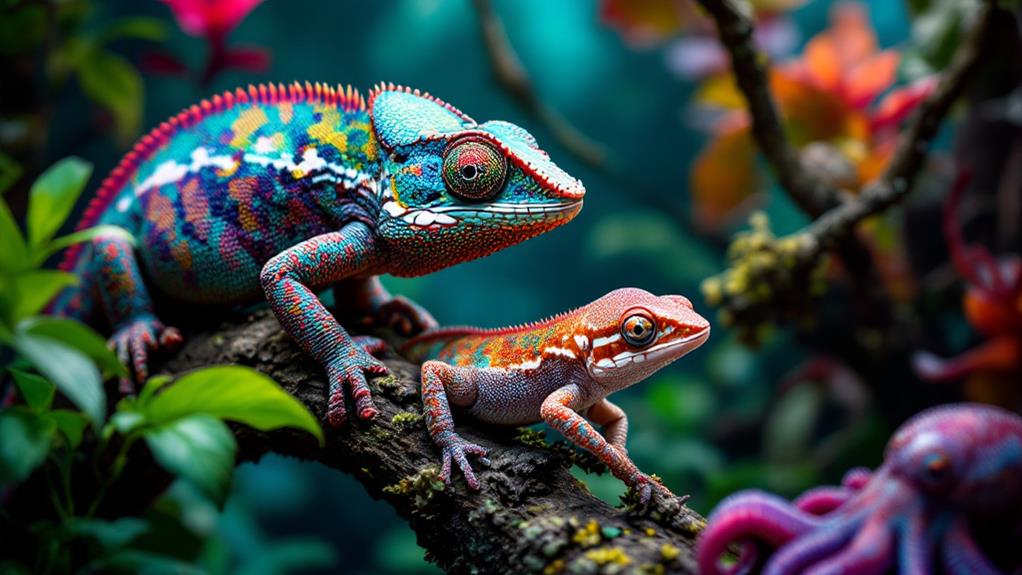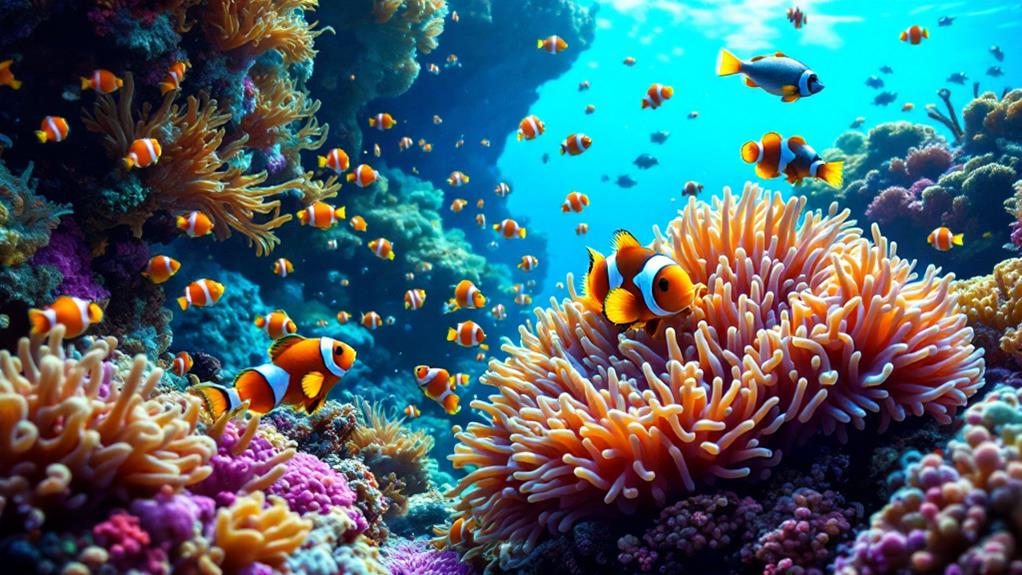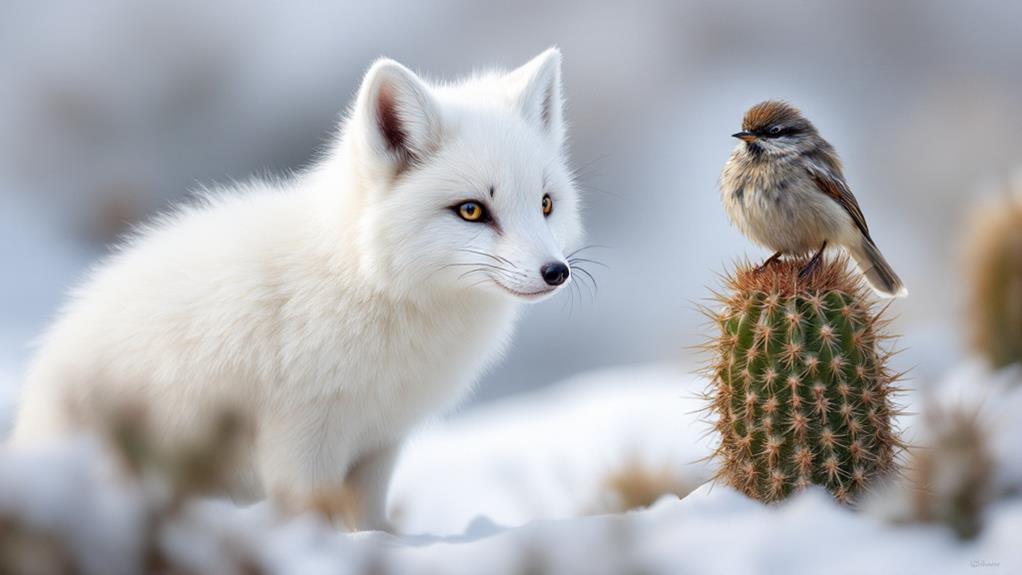Animal adaptations are fascinating ways species survive in their environments. You’ll find examples like camouflage, where Arctic foxes change coat color to blend with snow, or stick insects mimic twigs. Specialized body parts, such as a giraffe’s long neck or an elephant’s trunk, serve unique purposes. Some animals hibernate or estivate to endure harsh seasons. In the deep sea, bioluminescence helps creatures communicate and hunt. Echolocation allows bats and whales to navigate and find prey. From extreme temperature adaptations to symbiotic relationships, nature’s ingenuity is on full display. Exploring these adaptations reveals even more incredible survival strategies.
Camouflage and Mimicry

In spite of the constant threats in nature, many animals have evolved remarkable strategies for survival. Two of the most fascinating adaptations are camouflage and mimicry. These techniques allow creatures to blend in with their surroundings or imitate other species, providing essential protection from predators or helping them sneak up on prey.
You’ll find examples of camouflage everywhere in the animal kingdom. Arctic foxes change their coat color from brown to white in winter, seamlessly blending with the snowy landscape. Stick insects perfectly mimic twigs and leaves, making them nearly invisible to predators. Even large animals like leopards use their spotted coats to disappear into dappled forest shadows.
Mimicry takes camouflage a step further. Some animals don’t just blend in; they actively imitate other species. You’ve probably heard of the harmless milk snake mimicking the venomous coral snake‘s distinctive red, yellow, and black bands. This deception makes predators think twice before attacking. The zone-tailed hawk goes even further, flying like a vulture to fool its prey into letting their guard down.
In the insect world, you’ll encounter even more elaborate mimicry. Some butterflies imitate toxic species, gaining protection without actually being poisonous themselves. The orchid mantis looks so much like a flower that it not only avoids predators but also lures unsuspecting pollinating insects to their doom.
These adaptations showcase nature’s ingenuity in the face of survival challenges. They’re a reflection of the power of evolution, allowing countless species to thrive in environments full of danger.
Specialized Body Parts
Numerous animals have developed specialized body parts as remarkable adaptations for survival. These unique features enable them to thrive in their specific environments, overcome challenges, and outcompete rivals.
You’ll find an impressive array of specialized body parts in nature. Take the giraffe’s long neck, for instance. It’s evolved to reach leaves high up in trees, giving giraffes access to food sources other animals can’t reach. Similarly, the elephant’s trunk serves multiple purposes: it’s used for breathing, smelling, drinking, grasping objects, and even as a snorkel when swimming.
In aquatic environments, you’ll see adaptations like the streamlined bodies of sharks and dolphins, which allow for efficient movement through water. The webbed feet of ducks and frogs provide excellent propulsion for swimming. Meanwhile, the sharp claws and powerful legs of big cats enable them to chase down and capture prey with ease.
Some specialized body parts serve defensive purposes. The porcupine’s quills and the skunk’s scent glands are prime examples of adaptations that deter predators. The chameleon’s independently moving eyes give it a 360-degree field of vision, helping it spot both predators and prey.
You’ll also find specialized body parts that aid in unique feeding strategies. The anteater’s long, sticky tongue allows it to reach deep into ant nests, while the woodpecker’s reinforced skull and shock-absorbing brain case enable it to peck wood without injury.
These adaptations demonstrate nature’s incredible diversity and the power of evolution in shaping animals to fit their ecological niches.
Hibernation and Estivation
Animals’ survival strategies often include periods of dormancy to conserve energy during harsh conditions. Two common forms of this adaptation are hibernation and estivation. These processes allow creatures to survive when food is scarce or temperatures become extreme.
Hibernation is a state of inactivity that many animals enter during cold winters. You’ll find that hibernating animals remarkably lower their body temperature, heart rate, and metabolism. Bears, for example, can reduce their heart rate from 50 beats per minute to just 10. Groundhogs and bats are other well-known hibernators. During this time, they rely on stored fat reserves to survive.
Estivation, on the other hand, is a similar process that occurs in hot, dry conditions. It’s common among amphibians, reptiles, and some mammals in arid climates. When you observe an estivating animal, you’ll notice they become inactive and often bury themselves to avoid heat and conserve moisture. African lungfish, for instance, can estivate for years in dried mud, resuming normal activity when water returns.
Both hibernation and estivation require extensive preparation. Animals must build up fat reserves and find safe places to weather the harsh conditions. You’ll see behavioral changes as they prepare, such as increased feeding and den-building activities.
These adaptations aren’t limited to one type of animal. You’ll find hibernation and estivation across various species, from tiny insects to large mammals. Each has developed unique ways to enter and exit these states safely, showcasing nature’s incredible ability to adapt to challenging environments.
Bioluminescence
While many animals rely on camouflage or physical strength, some have evolved the remarkable ability to produce their own light. This phenomenon, known as bioluminescence, is a fascinating adaptation that serves various purposes in the animal kingdom.
You’ll find bioluminescent organisms in diverse habitats, but they’re particularly common in the deep sea. In these dark depths, creatures like anglerfish use their glowing lures to attract prey. The cookiecutter shark employs a different strategy, using its bioluminescent underside to blend in with the faint light from above, making it nearly invisible to potential prey below.
On land, you’re most likely to encounter bioluminescence in fireflies. These insects use their flashing lights for courtship, with males and females engaging in elaborate light-based communication to find mates. Some firefly species even mimic the light patterns of others to lure and eat unsuspecting rivals.
Bioluminescence isn’t limited to animals; you can also observe it in certain fungi and bacteria. The marine bacteria Vibrio fischeri form symbiotic relationships with creatures like the Hawaiian bobtail squid, providing light camouflage in exchange for nutrients.
The chemical process behind bioluminescence involves a light-emitting molecule called luciferin and an enzyme called luciferase. When these compounds interact with oxygen, they produce light. Different species have evolved variations of this process, resulting in a range of colors from blue-green to red.
Scientists are exploring practical applications of bioluminescence, including developing eco-friendly lighting solutions and using bioluminescent proteins as markers in medical research. As you examine deeper into this topic, you’ll discover that nature’s ability to create light continues to inspire both scientific inquiry and technological innovation.
Echolocation
Moving from the visual spectacle of bioluminescence, let’s explore another remarkable sensory adaptation in the animal kingdom. Echolocation is a sophisticated method some animals use to navigate and hunt in environments where vision is limited or ineffective.
You’ll find echolocation primarily in bats and toothed whales, but it’s also present in some birds and even a few terrestrial mammals. These animals emit high-frequency sounds and listen for the echoes that bounce back from objects in their environment. By analyzing these echoes, they can determine the location, size, and movement of objects around them with incredible precision.
Bats are the most well-known echolocators. They produce ultrasonic calls and use the returning echoes to create a detailed “sound picture” of their surroundings. This allows them to navigate in complete darkness, avoid obstacles, and catch flying insects with remarkable accuracy.
In the marine world, dolphins and other toothed whales use echolocation to find prey and communicate. They produce clicking sounds that travel through water and bounce off objects, helping them locate fish, squid, and other food sources.
Some cave-dwelling birds, like oilbirds and swiftlets, use a simpler form of echolocation to navigate in dark caves. They emit audible clicks and use the echoes to avoid colliding with cave walls or other obstacles.
Echolocation is a prime example of how evolution has equipped animals with extraordinary abilities to thrive in challenging environments. It’s a demonstration of nature’s ingenuity in solving sensory challenges across different species and habitats.
Extreme Temperature Adaptations
From scorching deserts to icy polar regions, many animals have evolved remarkable adaptations to survive extreme temperatures. You’ll find creatures that have developed unique physical features and behaviors to thrive in environments that would be lethal to most other species.
In hot climates, animals like camels have adapted to conserve water and regulate their body temperature. They’ve developed humps to store fat, allowing them to go for long periods without food or water. Their blood cells are oval-shaped, which helps them continue circulating even when the blood thickens due to dehydration. You’ll also see desert animals like fennec foxes with large ears that help dissipate heat.
On the other end of the spectrum, Arctic animals have evolved to withstand extreme cold. Polar bears, for example, have a thick layer of blubber and dense fur that traps air for insulation. Their small ears and tail minimize heat loss. Arctic foxes have fur that changes color seasonally, providing camouflage in both snowy and rocky terrains.
Some animals have developed behavioral adaptations to cope with temperature extremes. You might observe desert animals being nocturnal to avoid the intense daytime heat, while others estivate (enter a state of dormancy) during the hottest months. In cold regions, animals like Arctic ground squirrels can lower their body temperature to below freezing during hibernation, using a process called supercooling to prevent ice formation in their cells.
These adaptations demonstrate nature’s incredible ability to equip animals for survival in even the most challenging environments.
Symbiotic Relationships

Numerous animals have evolved to form symbiotic relationships, where two different species live in close association with one another. These partnerships can be mutually beneficial, or they may benefit one species while having little impact on the other. You’ll find fascinating examples of symbiosis throughout the animal kingdom.
One of the most well-known symbiotic relationships is between clownfish and sea anemones. The clownfish receives protection from predators by living among the anemone’s stinging tentacles, while the anemone benefits from the fish’s waste products and its ability to lure prey. Similarly, you’ll observe oxpeckers perching on large mammals like rhinos or zebras. These birds eat ticks and other parasites from the animal’s skin, providing pest control while getting an easy meal.
In the oceans, you’ll discover cleaner fish and shrimp that set up “cleaning stations” for larger fish. They remove parasites and dead skin from their “clients,” gaining a food source while the larger fish receive a health benefit. On land, you might spot ants tending to aphids, protecting them from predators in exchange for the sweet honeydew the aphids produce.
Some symbiotic relationships are even more intricate. Take the leafcutter ant and its fungus gardens. The ants cultivate a specific type of fungus, bringing it leaves to grow on, while the fungus provides food for the ant colony. This co-evolution has led to a relationship so specialized that neither species can survive without the other.
Unique Locomotion Methods
While symbiotic relationships showcase fascinating adaptations, the animal kingdom also boasts an array of unique locomotion methods. You’ll find that animals have evolved diverse ways to move through their environments, often tailored to their specific habitats and survival needs.
In the air, you’ll see hummingbirds employing a figure-eight wing motion that allows them to hover and fly backward. Flying squirrels use a flap of skin between their limbs to glide impressive distances between trees. Under the sea, you’ll observe the mesmerizing undulations of stingrays and the jet propulsion of squids and octopuses.
On land, you’ll encounter the kangaroo’s energy-efficient hopping and the inchworm’s unique looping gait. Sloths have adapted to move upside down through trees, using their long claws for support. Snakes employ a variety of techniques, including lateral undulation, sidewinding, and rectilinear locomotion.
You’ll find that some animals have developed specialized appendages for movement. The gecko’s toe pads, covered in microscopic hairs, allow it to climb smooth vertical surfaces and even walk on ceilings. Mountain goats have split hooves that can spread for better grip on rocky terrain.
In extreme environments, you’ll see adaptations like the sidewinder snake’s ability to move efficiently on loose sand, or the ice worm’s technique of burrowing through glaciers. These unique locomotion methods demonstrate the incredible diversity and adaptability of animal movement, each finely tuned to its specific ecological niche.
Defensive Mechanisms
Animals have developed an impressive array of defensive mechanisms to protect themselves from predators and environmental threats. You’ll find these adaptations fascinating, as they range from physical structures to chemical weapons and behavioral tactics.
One common defensive mechanism you’ll observe is camouflage. Many animals can blend in with their surroundings, making it difficult for predators to spot them. The chameleon‘s ability to change its skin color is a prime example, but don’t forget about creatures like stick insects and leaf-tailed geckos that mimic their environment.
Some animals have evolved physical defenses. You’ll notice porcupines with their sharp quills, armadillos with their tough shells, and hedgehogs with their spiny coats. These adaptations make it challenging for predators to attack or eat them.
Chemical defenses are another ingenious tactic. You’ll find skunks releasing their infamous spray, poison dart frogs with their toxic skin secretions, and bombardier beetles that eject a scalding chemical mixture at threats.
Behavioral defenses are equally important. You’ll see animals playing dead, like opossums, to discourage predators. Others, like meerkats, use a sentinel system where individuals take turns watching for danger while the group forages.
Some animals have developed mimicry as a defense. You’ll encounter harmless species that mimic dangerous ones, like the non-venomous milk snake resembling the deadly coral snake.
These defensive mechanisms showcase nature’s ingenuity in adapting to survive. As you explore the animal kingdom, you’ll discover even more remarkable ways creatures protect themselves from harm.

Erzsebet Frey (Eli Frey) is an ecologist and online entrepreneur with a Master of Science in Ecology from the University of Belgrade. Originally from Serbia, she has lived in Sri Lanka since 2017. Eli has worked internationally in countries like Oman, Brazil, Germany, and Sri Lanka. In 2018, she expanded into SEO and blogging, completing courses from UC Davis and Edinburgh. Eli has founded multiple websites focused on biology, ecology, environmental science, sustainable and simple living, and outdoor activities. She enjoys creating nature and simple living videos on YouTube and participates in speleology, diving, and hiking.

